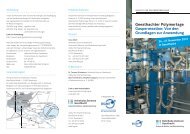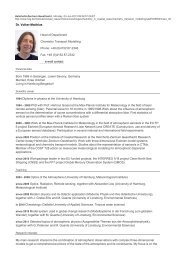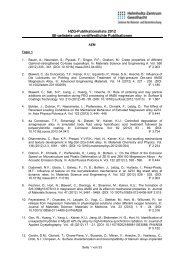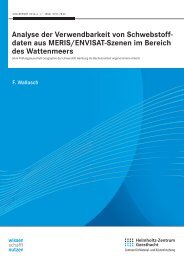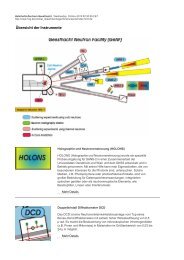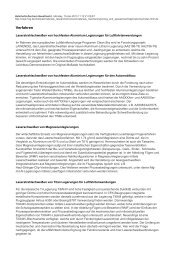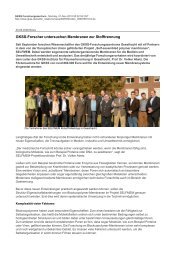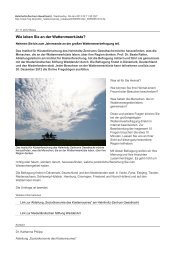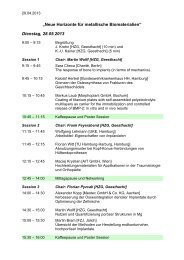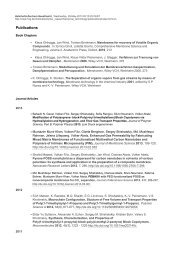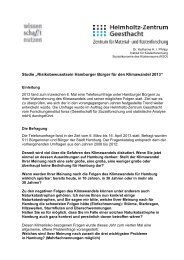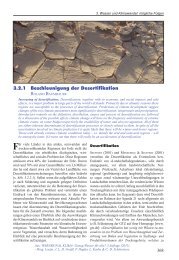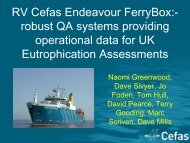Landfills and waste water treatment plants as sources of ... - GKSS
Landfills and waste water treatment plants as sources of ... - GKSS
Landfills and waste water treatment plants as sources of ... - GKSS
Create successful ePaper yourself
Turn your PDF publications into a flip-book with our unique Google optimized e-Paper software.
METHOD OPTIMISATION<br />
partly due to higher vapour pressures <strong>and</strong> therefore the incre<strong>as</strong>ed volatility <strong>of</strong> those<br />
compounds (for details see table 4 in section 1.3). Compared to FBE, higher recovery rates <strong>of</strong><br />
musk fragrances were obtained with ASE. This may be explained by volatilisation <strong>of</strong> musk<br />
fragrances during relatively long FBE extraction cycles (3 h). Furthermore, ASE is a “closed”<br />
system where analyte losses are minimized. The low recovery rate <strong>of</strong> MBDE183 in FBE<br />
extracts may be caused by the lower extraction strength <strong>of</strong> this technique. ASE operates at<br />
high temperatures <strong>and</strong> high pressures <strong>and</strong> is therefore <strong>as</strong>sumed to be the stronger extraction<br />
technique. Nevertheless, both techniques were suitable for extraction <strong>of</strong> musk fragrances <strong>and</strong><br />
PBDEs from GFF. However, the shorter extraction time <strong>of</strong> ASE (20 min) <strong>and</strong> lower amount<br />
<strong>of</strong> solvent underline the suitability <strong>of</strong> ASE that is therefore applied for further analysis.<br />
The clean-up step for PBDEs using silica gel <strong>and</strong> aluminium oxide revealed good recovery<br />
rates <strong>as</strong> displayed in figure 4 (section 3.3.6) <strong>and</strong> w<strong>as</strong> therefore applied for further analysis.<br />
Musk fragrances were not included into the purification experiment because they were<br />
estimated to be detected primarily in the g<strong>as</strong> ph<strong>as</strong>e (Kallenborn <strong>and</strong> Gatermann 2004; Peck<br />
<strong>and</strong> Hornbuckle 2006; Xie et al. 2007). Therefore, further optimisation <strong>of</strong> clean-up step for<br />
musk fragrances w<strong>as</strong> not considered.<br />
3.5 Conclusions<br />
First objective <strong>of</strong> this study w<strong>as</strong> to develop <strong>and</strong> optimize an analytical method that can<br />
efficiently <strong>and</strong> simultaneously extract PBDEs <strong>and</strong> musk fragrances from air sampling media.<br />
High recovery rates with low st<strong>and</strong>ard deviations for both substance groups revealed the high<br />
precision <strong>and</strong> good suitability <strong>of</strong> evaluated methods.<br />
For simultaneous determination <strong>of</strong> PBDEs <strong>and</strong> musk fragrances GC oven program <strong>and</strong> inlet<br />
parameters were optimized. Separation factors revealed good chromatographic separation for<br />
most <strong>of</strong> the target analytes. However, some musk fragrances could not be sufficiently<br />
separated but it w<strong>as</strong> possible to quantify those compounds by different m/z. Inlet parameter<br />
optimisation revealed a distinct incre<strong>as</strong>e <strong>of</strong> PBDE <strong>and</strong> musk fragrances sensitivity. With these<br />
inlet modifications an average improvement <strong>of</strong> sensitivity <strong>of</strong> 9 % for PBDEs <strong>and</strong> musk<br />
fragrances w<strong>as</strong> achieved if compared to the starting PTV settings in section 3.2.2. Figure 6<br />
demonstrates improvements in sensitivity for each compound.<br />
40



